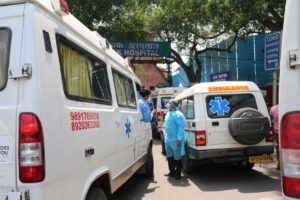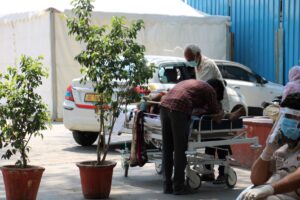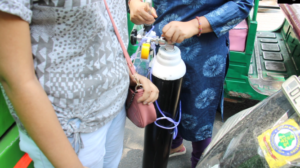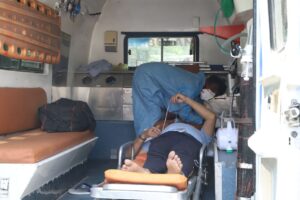Second wave of coronavirus renders hospitals in Delhi hopeless
Ever since the pandemic broke last year, Lok Nayak Jai Prakash hospital in Delhi has been at the forefront of the capital’s fight against Covid19, leading the charge of hospitals run by the Delhi government in the city. But while it proved effective last year, in face of the second wave of the pandemic that has been ravaging the nation and its capital alike for over a month now, the iconic LNJP hospital is now running to its full capacity, with no room for any more patients despite the ongoing flood of fresh arrivals every day.
On Thursday, the scene was no different. At the gates of the hospital were distraught family members trying to get their relatives admitted, but ran into a wall of security guards, standing in front of closed gates, who have been tasked with the tough job of explaining the situation to them and turning them away, in despair.
The guards are not letting even ambulances inside because of the huge rush of ambulances. It is only when the family fulfils all the formalities and gets a bed, that the ambulances are allowed inside. The total number of beds in the hospital is 1,500. This includes 400 for ICU patients and 200 for those on a ventilator.

With no more beds hospital staff keep ambulances carrying patients outside the hospital (MIG photos/Richa Nigam)
A woman in her forties, who has been waiting inside an ambulance with her brother, who has tested positive and needs to be admitted, says that the bed is confirmed but it’s not yet ready for her brother. “My other brother has gone inside to talk to the officials and they have assured that we will get a bed. We are just waiting now,” says the resident of Pitam Pura, in north-west Delhi.
Hers is not an isolated case. A number of ambulances, with patients in varying degrees of serious condition, are lined up outside the hospital. Patients in ambulances are waiting to cross the gates that open very infrequently and that too only to allow the very few fortunate ones. Relatives and friends run around in desperation, pleading with anyone, starting from the security guards to the superintendent of the hospital, with the hope of getting a bed.
“The hospital authorities are not admitting my son. People here are saying there is no one ready to admit him. We are running for three days to get him tested. They are asking me to get him tested from outside. I am myself old, how will I take him everywhere? I am not getting a single bed for my son anywhere. He is not able to breathe. I have no one. It’s just the two of us,” says a woman who is struggling to find a bed for her 40-year-old son.
She is not the only one struggling to find a bed. A man in his 50’s says that his relative is having difficulty in breathing and has high fever. However, none of the hospitals are testing her and he can’t even get her admitted. “Her oxygen level is just between 35 and 38. I am coming from Lady Hardinge hospital just now, but they refused to admit her. We came here with some hope but we see that the situation is worse here. They are not even asking us what we want. We have already tried Yamuna Vihar hospital and three other private hospitals. All of them have refused a bed saying the patients’ condition is very critical and nothing can be done,” he pleads.

A man holding his mother lying on a stretcher while they wait for help in the hospital (MIG photos/Varsha Singh)
But the challenge of the patients and their relatives does not end with admission. Patients who have been admitted remain totally cut off from their families who complain of a total lack of information about the state of the patients and regular updates on their health and if they need anything. This lack of communication makes some families believe that their next of kin are not being cared for properly by the medical staff.
Abhishek whose mother Rekha has been admitted in the hospital for the past one week says that he is not sure who is taking care of his mother. “There is not a single nurse in the hospital who is taking care of my mother. They don’t allow me to meet her and she complains on phone that they don’t even give her water,” he says.
A woman whose husband, 48, has been admitted for the past four days to an Intensive Care Unit of the LNJP hospital also says that the hospital staff is not providing water to the patients. “My husband told me over the telephone that there is complete mismanagement inside the hospital. They are not giving him water properly and at night they lock the doors of the ICU wards from outside. He cannot even ask for help if he needs someone at night. He tells me ‘whom should I ask? There is no one here’. He has his own oximeter as there is not a single person to check his oxygen level. This morning he said his oxygen level was only 60,” she says in desperation.

A woman waiting with an oxygen cylinder for her husband outside the hospital (MIG photos/Varsha Singh)
Uncertain of what is happening inside the hospital that is clearly stretched beyond its limits seeing the crush of patients inside and outside, the woman is considering taking her husband away. “I don’t know what will happen to him inside the hospital that is why either I will move him to some other hospital or I will take him back home. At least there will be people to look after him. But the officials say we will not release him before two days,” she says, waiting at the perimeter of the hospital, with her teenaged daughter who is holding on to an oxygen cylinder for her father.
Gasping for breath
Indeed, the omnipresent oxygen has become one of the rarest and most precious commodities across India over the last fortnight as hospitals ran out of supplies, leading to several deaths by asphyxiation due to a severe shortage of oxygen. News reports have been pouring in from across the nation that even the most renowned hospitals had less than a few hours of oxygen supplies left. State governments blocked oxygen manufacturers from sending supplies to hospitals outside their states and in all this melee, it was the relatives of the patients who were left to hunt for oxygen supplies themselves.
And as is common in India, with demand shooting up prices spiralled. Cost of an empty cylinder spiked from about INR 3,000 to INR 20,000 and refills that cost normally around INR 300 were priced 10 times higher. Despite such eye-watering prices, oxygen was out of stock practically all over. Thus, whenever the hospitals received the precious little supplies of cylinders, patients jumped on them and fought each other to get hold of a cylinder. The same scenario was seen at the distributors’ offices across the nation and in Delhi, with social media flooded with pleas for oxygen cylinders.
And as if this was not enough, an old man in his 70’s got out of an ambulance, with his daughter holding an oxygen cylinder for him, sat right outside the hospital. It was only after 20-25 minutes that the hospital authorities arranged wheelchair for him after which he could enter the hospital.
Finally, Max Super Speciality hospitals, a large chain of private hospitals, was forced to approach the courts of law over the supply. It asked the Delhi High Court for help. In a furious query, the High Court pulled up the Centre, questioning why it waited for the situation to become so severe before barring manufacture of oxygen for industrial use and divert it for medical purposes only. “Economic interests can’t override human lives. Else we are heading for a disaster,” the court said. High Courts in Mumbai and Allahabad were also hearing the matter and now even the Supreme Court has stepped in, asking the government to prepare an ‘oxygen plan’.










